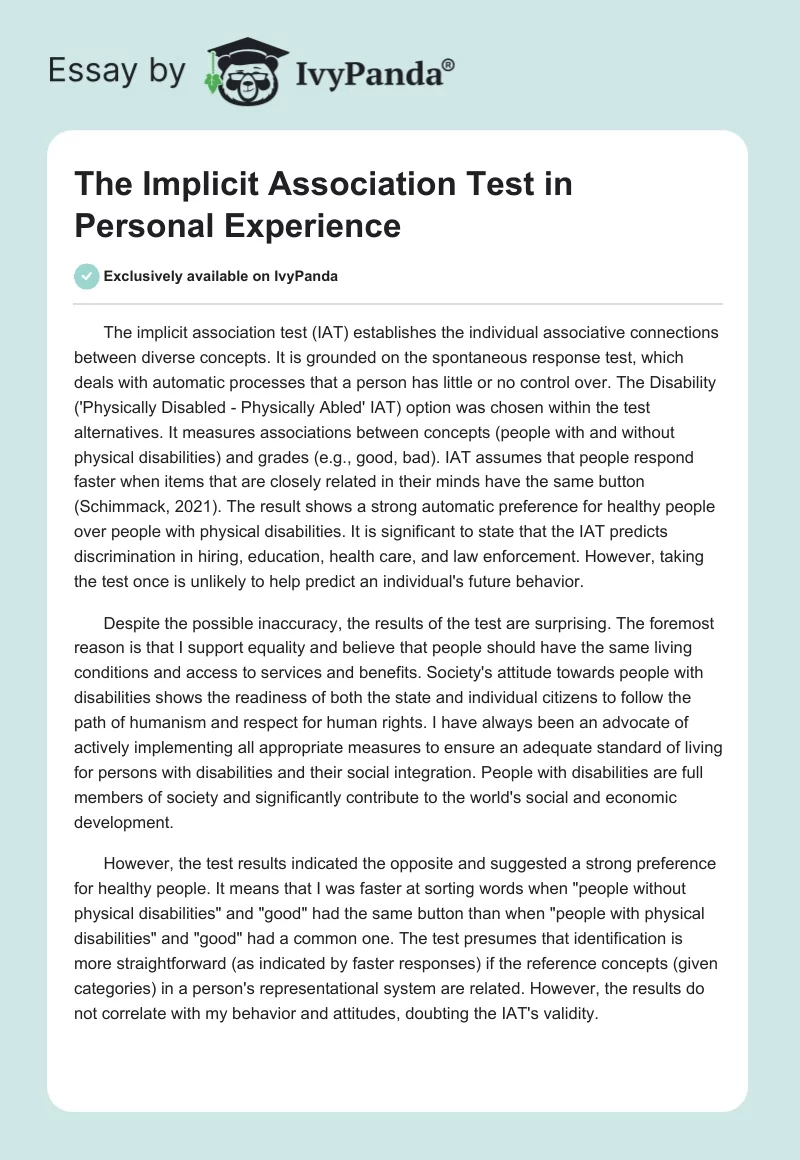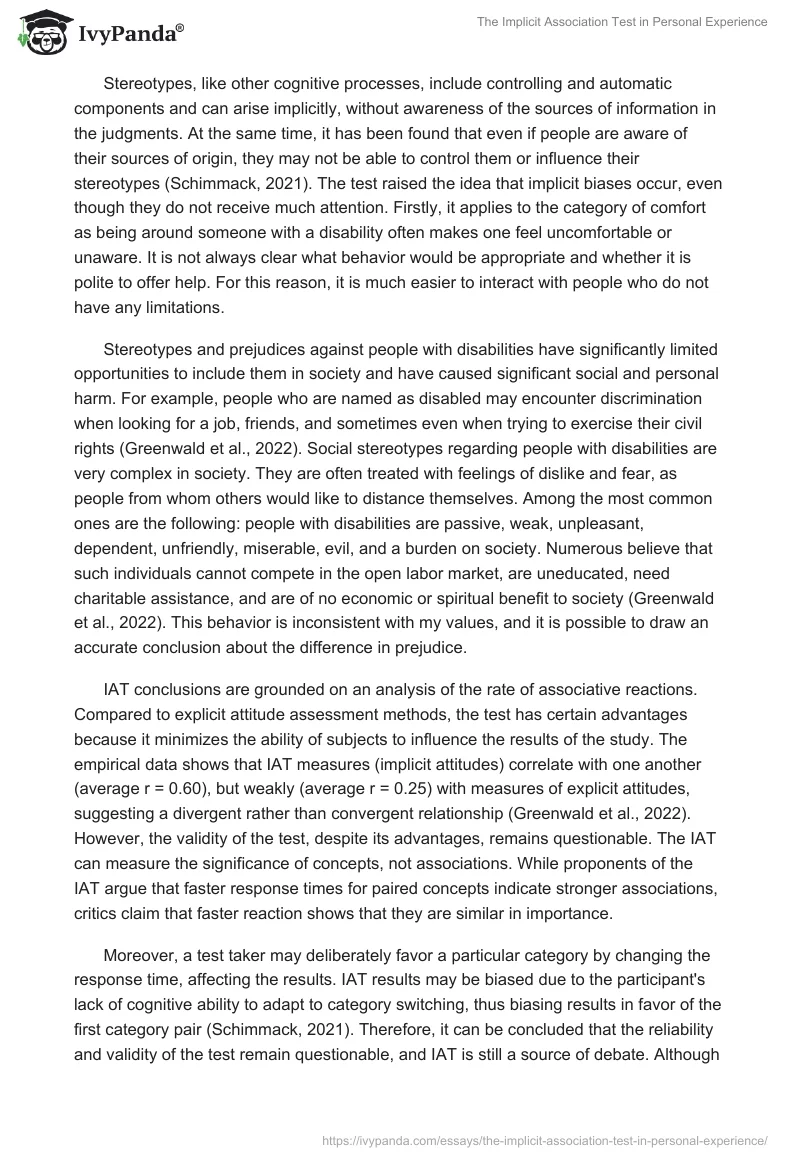The implicit association test (IAT) establishes the individual associative connections between diverse concepts. It is grounded on the spontaneous response test, which deals with automatic processes that a person has little or no control over. The Disability (‘Physically Disabled – Physically Abled’ IAT) option was chosen within the test alternatives. It measures associations between concepts (people with and without physical disabilities) and grades (e.g., good, bad). IAT assumes that people respond faster when items that are closely related in their minds have the same button (Schimmack, 2021). The result shows a strong automatic preference for healthy people over people with physical disabilities. It is significant to state that the IAT predicts discrimination in hiring, education, health care, and law enforcement. However, taking the test once is unlikely to help predict an individual’s future behavior.
Despite the possible inaccuracy, the results of the test are surprising. The foremost reason is that I support equality and believe that people should have the same living conditions and access to services and benefits. Society’s attitude towards people with disabilities shows the readiness of both the state and individual citizens to follow the path of humanism and respect for human rights. I have always been an advocate of actively implementing all appropriate measures to ensure an adequate standard of living for persons with disabilities and their social integration. People with disabilities are full members of society and significantly contribute to the world’s social and economic development.
However, the test results indicated the opposite and suggested a strong preference for healthy people. It means that I was faster at sorting words when “people without physical disabilities” and “good” had the same button than when “people with physical disabilities” and “good” had a common one. The test presumes that identification is more straightforward (as indicated by faster responses) if the reference concepts (given categories) in a person’s representational system are related. However, the results do not correlate with my behavior and attitudes, doubting the IAT’s validity.
Stereotypes, like other cognitive processes, include controlling and automatic components and can arise implicitly, without awareness of the sources of information in the judgments. At the same time, it has been found that even if people are aware of their sources of origin, they may not be able to control them or influence their stereotypes (Schimmack, 2021). The test raised the idea that implicit biases occur, even though they do not receive much attention. Firstly, it applies to the category of comfort as being around someone with a disability often makes one feel uncomfortable or unaware. It is not always clear what behavior would be appropriate and whether it is polite to offer help. For this reason, it is much easier to interact with people who do not have any limitations.
Stereotypes and prejudices against people with disabilities have significantly limited opportunities to include them in society and have caused significant social and personal harm. For example, people who are named as disabled may encounter discrimination when looking for a job, friends, and sometimes even when trying to exercise their civil rights (Greenwald et al., 2022). Social stereotypes regarding people with disabilities are very complex in society. They are often treated with feelings of dislike and fear, as people from whom others would like to distance themselves. Among the most common ones are the following: people with disabilities are passive, weak, unpleasant, dependent, unfriendly, miserable, evil, and a burden on society. Numerous believe that such individuals cannot compete in the open labor market, are uneducated, need charitable assistance, and are of no economic or spiritual benefit to society (Greenwald et al., 2022). This behavior is inconsistent with my values, and it is possible to draw an accurate conclusion about the difference in prejudice.
IAT conclusions are grounded on an analysis of the rate of associative reactions. Compared to explicit attitude assessment methods, the test has certain advantages because it minimizes the ability of subjects to influence the results of the study. The empirical data shows that IAT measures (implicit attitudes) correlate with one another (average r = 0.60), but weakly (average r = 0.25) with measures of explicit attitudes, suggesting a divergent rather than convergent relationship (Greenwald et al., 2022). However, the validity of the test, despite its advantages, remains questionable. The IAT can measure the significance of concepts, not associations. While proponents of the IAT argue that faster response times for paired concepts indicate stronger associations, critics claim that faster reaction shows that they are similar in importance.
Moreover, a test taker may deliberately favor a particular category by changing the response time, affecting the results. IAT results may be biased due to the participant’s lack of cognitive ability to adapt to category switching, thus biasing results in favor of the first category pair (Schimmack, 2021). Therefore, it can be concluded that the reliability and validity of the test remain questionable, and IAT is still a source of debate. Although its methodology is elaborate and can indeed help to identify biases, the results cannot be considered genuine in every case.
References
Greenwald, A. G., Brendl, M., Cai, H., Cvencek, D., Dovidio, J. F., Friese, M., & Wiers, R. W. (2022). Best research practices for using the Implicit Association Test.Behavior Research Methods, 54(3), 1161-1180. Web.
Schimmack, U. (2021). The Implicit Association Test: A method in search of a construct. Perspectives on Psychological Science, 16(2), 396-414. Web.


